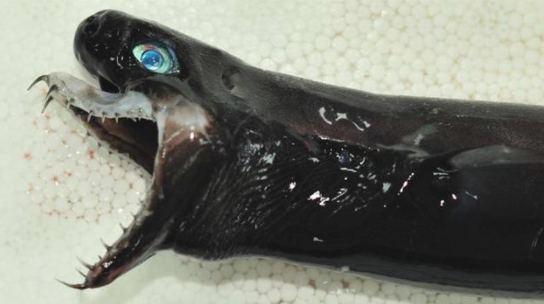They were first captured and identified in 1986, but in the 32 years since, they’ve been seen only rarely and often just by accident.
 Viper dogfish, Trigonognathus kabeyai, are a deep-sea dwelling type of small shark. Five were recently dredged up as bycatch off the coast of Taiwan.
Viper dogfish, Trigonognathus kabeyai, are a deep-sea dwelling type of small shark. Five were recently dredged up as bycatch off the coast of Taiwan.
The sharks were found during a routine fish survey conducted by a local research institute, according to local reports.
They’re thought to be ram feeders, also called lunge feeders, and hunt by swimming into prey mouth agape. Studies on the sharks’ stomach contents revealed they likely swallow their prey whole.
On their bodies, viper dogfish have little cells that produce light called photophores. These cells help the fish emit light in the deep sea, which may help them in hunting or mating. Like all sharks, these fish also have small, v-shaped scales called dermal denticles, which makes their skin tough and helps them swim away quickly and quietly.
Why Is So Little Known About Them?
The International Union for the Conservation of Nature lists the viper dogfish as “data deficient” because so little is known about their populations.
Viper dogfish have only been found in waters off the coasts of Japan, Taiwan, and Hawaii. According to interviews given to a Taiwanese outlet, they’re thought to vertically migrate, meaning they swim at depths of 1,000 feet at night and swim as close as 500 feet from the surface during the day.
The fish that were caught ranged in length from 10 to 12 inches, and previous catches measured no more than 18 inches long.
Their small, narrow bodies may help them evade mesh fishing nets, biologist Brit Finucci told Earth Touch News.
Of the five that were caught, one was reportedly still alive when it was pulled from the water. Researchers submerged it and hoped to keep it alive to study it further, but it died within 24 hours of capture.


